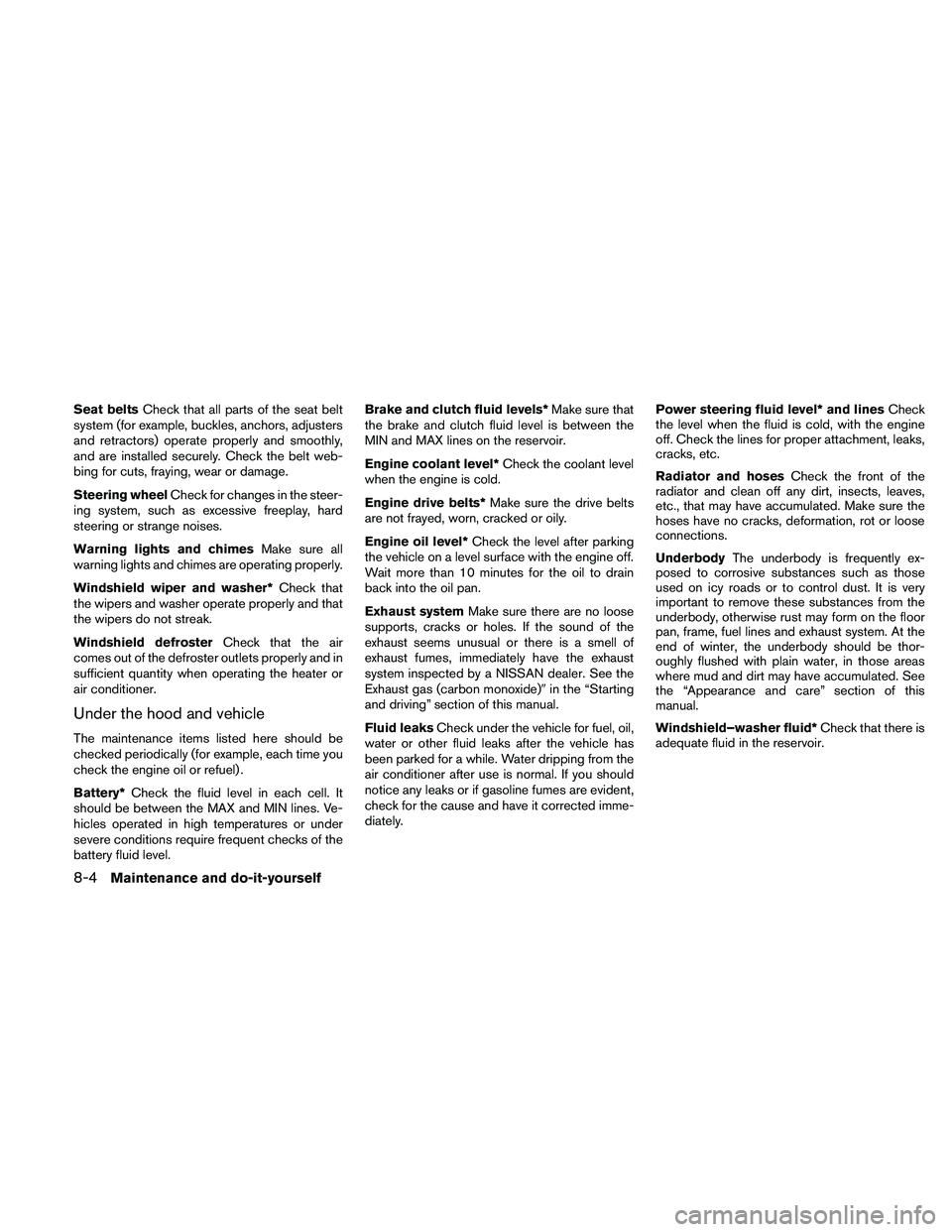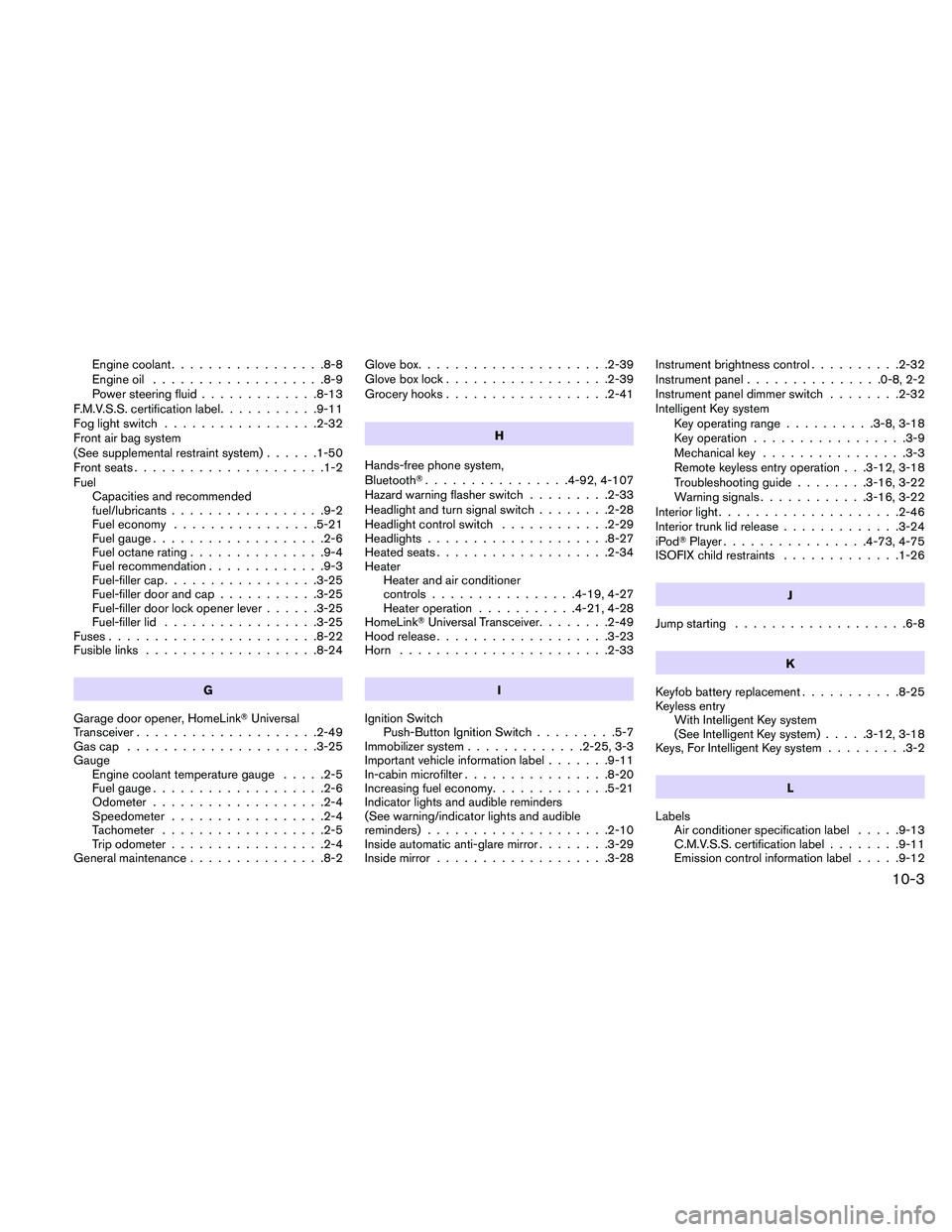Page 17 of 438
QR25DE engine
1. Power steering fluid reservoir (P. 8-13)
2. Engine oil filler cap (P. 8-9)
3. Brake fluid reservoir/Clutch fluidreservoir (M/T model) (P. 8-14, 8-14)
4. Air cleaner (P. 8-19)
5. Fuse block (P. 8-22)
6. Battery (P. 8-15)
7. Fuse/fusible link box (P. 8-22)
8. Engine oil dipstick (P. 8-9)
9. Radiator cap (P. 8-8)
10. Drive belt location (P. 8-18)
11. Engine coolant reservoir (P. 8-8)
12. Windshield-washer fluid reservoir
(P. 8-15)
See the page number indicated in paren-
theses for operating details.
Page 18 of 438
VQ35DE engine
1. Power steering fluid reservoir (P. 8-13)
2. Engine oil filler cap (P. 8-9)
3. Brake fluid reservoir/Clutch fluidreservoir (M/T model) (P. 8-14, 8-14)
4. Air cleaner (P. 8-19)
5. Fuse block (P. 8-22)
6. Battery (P. 8-15)
7. Fuse/fusible link box (P. 8-22)
8. Engine oil dipstick (P. 8-9)
9. Radiator cap (P. 8-8)
10. Drive belt location (P. 8-18)
11. Engine coolant reservoir (P. 8-8)
12. Windshield-washer fluid reservoir
(P. 8-15)
See the page number indicated in paren-
theses for operating details.
Page 357 of 438

Seat beltsCheck that all parts of the seat belt
system (for example, buckles, anchors, adjusters
and retractors) operate properly and smoothly,
and are installed securely. Check the belt web-
bing for cuts, fraying, wear or damage.
Steering wheel Check for changes in the steer-
ing system, such as excessive freeplay, hard
steering or strange noises.
Warning lights and chimes Make sure all
warning lights and chimes are operating properly.
Windshield wiper and washer* Check that
the wipers and washer operate properly and that
the wipers do not streak.
Windshield defroster Check that the air
comes out of the defroster outlets properly and in
sufficient quantity when operating the heater or
air conditioner.
Under the hood and vehicle
The maintenance items listed here should be
checked periodically (for example, each time you
check the engine oil or refuel) .
Battery* Check the fluid level in each cell. It
should be between the MAX and MIN lines. Ve-
hicles operated in high temperatures or under
severe conditions require frequent checks of the
battery fluid level. Brake and clutch fluid levels*
Make sure that
the brake and clutch fluid level is between the
MIN and MAX lines on the reservoir.
Engine coolant level* Check the coolant level
when the engine is cold.
Engine drive belts* Make sure the drive belts
are not frayed, worn, cracked or oily.
Engine oil level* Check the level after parking
the vehicle on a level surface with the engine off.
Wait more than 10 minutes for the oil to drain
back into the oil pan.
Exhaust system Make sure there are no loose
supports, cracks or holes. If the sound of the
exhaust seems unusual or there is a smell of
exhaust fumes, immediately have the exhaust
system inspected by a NISSAN dealer. See the
Exhaust gas (carbon monoxide)� in the “Starting
and driving” section of this manual.
Fluid leaks Check under the vehicle for fuel, oil,
water or other fluid leaks after the vehicle has
been parked for a while. Water dripping from the
air conditioner after use is normal. If you should
notice any leaks or if gasoline fumes are evident,
check for the cause and have it corrected imme-
diately. Power steering fluid level* and lines
Check
the level when the fluid is cold, with the engine
off. Check the lines for proper attachment, leaks,
cracks, etc.
Radiator and hoses Check the front of the
radiator and clean off any dirt, insects, leaves,
etc., that may have accumulated. Make sure the
hoses have no cracks, deformation, rot or loose
connections.
Underbody The underbody is frequently ex-
posed to corrosive substances such as those
used on icy roads or to control dust. It is very
important to remove these substances from the
underbody, otherwise rust may form on the floor
pan, frame, fuel lines and exhaust system. At the
end of winter, the underbody should be thor-
oughly flushed with plain water, in those areas
where mud and dirt may have accumulated. See
the “Appearance and care” section of this
manual.
Windshield–washer fluid* Check that there is
adequate fluid in the reservoir.
8-4Maintenance and do-it-yourself
Page 359 of 438
QR25DE engine
1. Power steering fluid reservoir
2. Engine oil filler cap
3. Brake fluid reservoir/Clutch fluidreservoir (M/T model)
4. Air cleaner
5. Fuse block
6. Battery
7. Fuse/Fusible link box
8. Engine oil dipstick
9. Radiator cap
10. Drive belt location
11. Engine coolant reservoir
12. Windshield–washer fluid reservoir
Page 360 of 438
VQ35DE engine
1. Power steering fluid reservoir
2. Engine oil filler cap
3. Brake fluid reservoir/Clutch fluidreservoir (M/T model)
4. Air cleaner
5. Fuse block
6. Battery
7. Fuse/Fusible link box
8. Engine oil dipstick
9. Radiator cap
10. Drive belt location
11. Engine coolant reservoir
12. Windshield–washer fluid reservoir
Page 366 of 438
CAUTION
●Use only Genuine NISSAN CVT Fluid
NS-2. Do not mix with other fluids.
● Using transmission fluid other than
Genuine NISSAN CVT Fluid NS-2 will
damage the CVT, which is not covered
by the NISSAN new vehicle limited
warranty.
When checking or replacement of CVT fluid is
required, we recommend your NISSAN dealer for
servicing.
The fluid level should be checked using the HOT
MAX range on the power steering fluid reservoir
at fluid temperatures of 122° - 176°F (50° -
80°C) or using the COLD MAX range on the
power steering fluid reservoir at fluid tempera-
tures of 32° - 86°F (0° - 30°C) .
If the fluid is at or below the MIN line, add Genu-
ine NISSAN PSF to HOT MAX or COLD MAX
depending on system fluid temperature. Remove
the cap and fill through the opening.
Page 371 of 438
1. Power steering fluid pump pulley
2. Water pump pulley
3. Generator
4. Air conditioner
5. Crankshaft pulley
6. Drive belt Automatic tensioner
Page 432 of 438

Engine coolant.................8-8
Engine oil ...................8-9
Power steering fluid .............8-13
F.M.V.S.S. certification label ...........9-11
Fog light switch .................2-32
Front air bag system
(See supplemental restraint system) ......1-50
Front seats .....................1-2
Fuel Capacities and recommended
fuel/lubricants .................9-2
Fuel economy ................5-21
Fuel gauge ...................2-6
Fuel octane rating ...............9-4
Fuel recommendation .............9-3
Fuel-filler cap .................3-25
Fuel-filler door and cap ...........3-25
Fuel-filler door lock opener lever ......3-25
Fuel-filler lid .................3-25
Fuses .......................8-22
Fusible links ...................8-24
G
Garage door opener, HomeLink� Universal
Transceiver ....................2-49
Gascap .....................3-25
Gauge Engine coolant temperature gauge .....2-5
Fuel gauge ...................2-6
Odometer ...................2-4
Speedometer .................2-4
Tachometer ..................2-5
Trip odometer .................2-4
General maintenance ...............8-2 Glove box
.....................2-39
Glove box lock ..................2-39
Grocery hooks ..................2-41
H
Hands-free phone system,
Bluetooth� ................4-92, 4-107
Hazard warning flasher switch .........2-33
Headlight
and turn signal switch ........2-28
Headlight control switch ............2-29
Headlights ....................8-27
Heated seats ...................2-34
Heater Heater and air conditioner
controls ................4-19, 4-27
Heater operation ...........4-21, 4-28
HomeLink� Universal Transceiver ........2-49
Hood release ...................3-23
Horn .......................2-33
I
Ignition Switch Push-Button Ignition Switch .........5-7
Immobilizer system .............2-25, 3-3
Important vehicle information label .......9-11
In-cabin microfilter ................8-20
Increasing fuel economy .............5-21
Indicator lights and audible reminders
(See warning/indicator lights and audible
reminders) ....................2-10
Inside automatic anti-glare mirror ........3-29
Inside mirror ...................3-28 Instrument brightness control
..........2-32
Instrument panel ...............0-8, 2-2
Instrument panel dimmer switch ........2-32
Intelligent Key system Key operating range ..........3-8, 3-18
Key operation .................3-9
Mechanical key ................3-3
Remote keyless entry operation . . .3-12, 3-18
Troubleshooting guide ........3-16, 3-22
Warning signals ............3-16, 3-22
Interior light ....................2-46
Interior trunk lid release .............3-24
iPod� Player................4-73, 4-75
ISOFIX child restraints .............1-26
J
Jump starting .................. .6-8
K
K
eyfob battery replacement ...........8-25
Keyless entry With Intelligent Key system
(See Intelligent Key system) .....3-12, 3-18
Keys, For Intelligent Key system .........3-2
L
Labels Air conditioner specification label .....9-13
C.M.V.S.S. certification label ........9-11
Emission control information label .....9-12
10-3